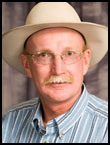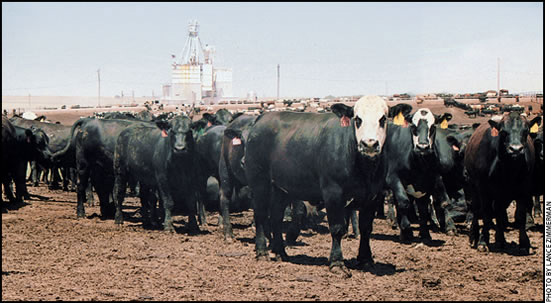MANAGEMENT...
Featured Feedlot:
Hays Feeders LLC
CAB partner in customer success for 10 years.
Knowledge and dedication, combined with passion, comprise just the right formula. Just ask Bill Sleigh, manager of Hays Feeders LLC.
"Success is a combination of high-quality cattle fed with the right ration and marketed at the right time in the right way," he says. The staff works long hours to get there, but they don't mind doing what benefits customers. Click here for more.

Ron Torell
Back to Basics
Technology hypocrites
Information overload! This best describes the e-mail inboxes of the authors of this article. If you are of the "over-50" generation, you probably feel the same way. In addition to e-mails, the now favored means of communication by the younger generation is texting. Let's not forget Facebook, YouTube and MySpace, twittering, blogging and chatting. When the over-50 generation was growing up, "my space" was where you were not.
How do people find time to enjoy life, get their work done and still fully participate in all these modern forms of communication? Click here to read more.
ARSBC Coverage:
Management Factors Affecting Fertility
 SDSU's George Perry gives insight into the management factors affecting fertility in synchronized and natural-breeding programs.
SDSU's George Perry gives insight into the management factors affecting fertility in synchronized and natural-breeding programs.
The cow-calf business is really all about reproduction. The goal of any serious cow-calf producer is to maximize the number of cows and heifers that become pregnant. So fertility is pretty important. During the Applied Reproductive Strategies in Beef Cattle (ARSBC) workshop hosted in conjunction with the 2010 Cattle Industry Annual Convention, South Dakota State University (SDSU) reproductive physiologist George Perry talked about factors influencing fertility. He also offered up a number of managerial considerations for maximizing pregnancy rates for breeding programs utilizing natural service or artificial insemination (AI).
Perry advised producers to consider the "equation of reproduction," which includes four factors:
1. the percentage of females detected in estrus (standing heat) and inseminated;
2. inseminator efficiency;
3. the fertility level of the breeding herd; and
4. the fertility of the semen.
According to Perry, overall reproductive performance of the breeding herd will never be better than the lowest level of performance in any one of these areas. Click here for more.
ARSBC Coverage:
Understanding Females
 Gary Williams offers tips for understanding puberty and postpartum anestrus.
Gary Williams offers tips for understanding puberty and postpartum anestrus.
Getting cows pregnant isn't always as easy as it sounds, but understanding puberty and postpartum anestrus can make it a bit easier. Gary Williams, Texas A&M University, addressed these topics Jan. 28 at the ARSBC Symposium in San Antonio. Click here to read more.
ARSBC Coverage:
The Short List
 Task Force provides 2010 recommendations for timing of AI and synchronization protocols for heifers and cows.
Task Force provides 2010 recommendations for timing of AI and synchronization protocols for heifers and cows.
Sandy Johnson, Kansas State University livestock production specialist, shared an update on the efforts of the North Central Region Bovine Reproductive Task Force as she addressed participants at the ARSBC workshop in San Antonio.
The Task Force has developed a "short list" of basic recommendations for timing of artificial insemination (AI) and protocols that work specifically for heifers and a separate list for cows.
"These are the protocols that the Task Force believes will work in a majority of situations and are reasonable to apply," Johnson said, adding that the list is updated on an annual basis. Click here to read more.

Kris Ringwall
Beef Talk
No sun, no fun.
When the sun is out, the calves, cows and horses are happy. The rancher, farmer and family are happy. A long period without sunny days definitely turns the tide away from happiness. Perhaps that is why the saying "a cloudy day" has so many meanings.
Sunlight affects living things because they need sunlight to survive. The biological pathways of living things depend on sunshine. Sunlight is converted into biological compounds that exist within the bodies of living things.
Photoreceptors in the retina of the eye can be activated by light. These receptor cells send neural impulses deep into the brain to sites such as the hypothalamus. The hypothalamus passes these impulses through an assortment of pathways that end up in the pineal gland, which also is deep within the brain. The pineal gland converts the neural signals into hormonal outputs that tell the various parts of the body what is going on in the bigger picture. Click here to read more.
DNA Tests Can Verify Sires
Breeders in mountain country using large pastures find it difficult to run single-sire groups and obtain adequate pregnancy rates. But it's hard to evaluate whether a bull helped or hindered the quality of your calf crop if you can't tell which calves are his.
Parentage verification using DNA testing now allows breeders to turn out several bulls with a large group of cows and still verify parentage. The process works especially well if the sires are not too closely related. Half brothers (or father and sons, or any other close relationship) may share a high percentage of the same markers, making differentiation more complicated. They can still be differentiated; it just takes more markers, and that means more cost.
Even then, it may still be cost-effective due to the benefits of using multi-sire pastures — increasing the chance of cows getting bred, improving efficiency of pasture use and possibly increasing aggressiveness of bulls due to competition.
Parentage verification through DNA typing may also be useful for producers using a cleanup bull natural service following an artificial insemination (AI) program. If a calf is born between the estimated calving date to the AI breeding and the estimated calving date to natural service, DNA typing may be necessary to identify the sire.
New Products
Industry affiliates provide a wide array of products and services to assist you on the farm and ranch. Here's an assortment of new products to hit the market in the last few months.
• High-density bovine beadchip
• Online assessment tool for balances and scales
• Waterer
• Workwear rental program, contest
• Weld and run auxiliary tools
Angus Advisor





